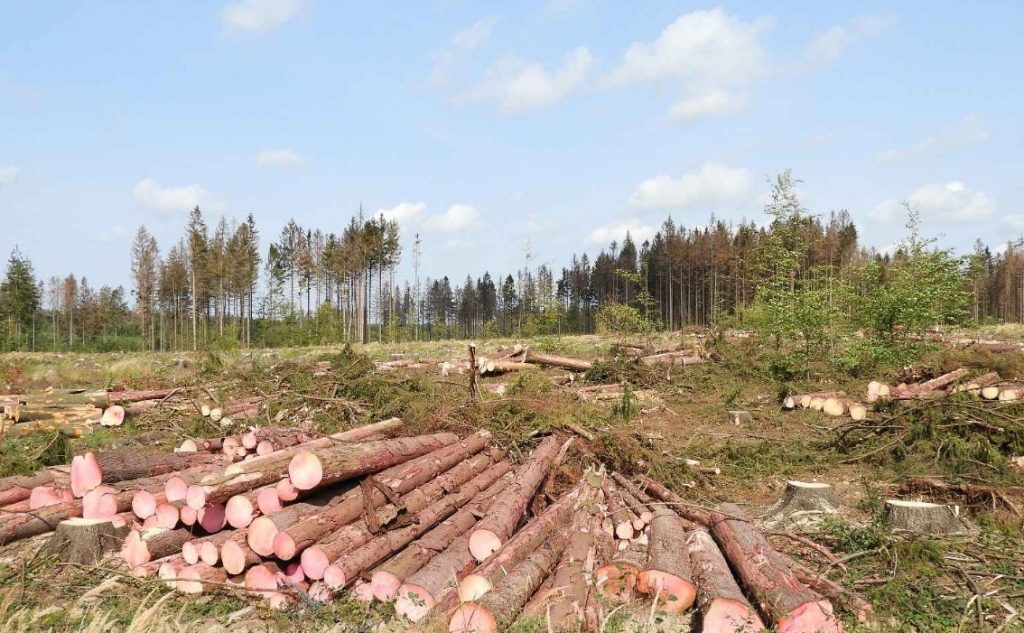Is the bark beetle just a pest or can it also help? And will it help us create more resilient forests for an uncertain future? Forest entomologist Roman Modlinger talks about the state of the landscape of the Olomouc Region in the Czech Republic.
Doctor, if we are talking about a bark beetle – what exactly is it, who is it?
Bark beetles are tiny beetles 0.5-12 mm long that live under the bark of our trees. There are roughly 100 species in the Czech Republic. In colloquial terms, we usually refer to the spruce bark beetle, which is our most important species. The spruce bark beetle develops in the bark of spruce trees, where it creates a typical pattern – a gobbler. The tree is always occupied en masse by many families, and during the feeding of the larvae, the attacked tree gradually dies.

Is the bark beetle of natural importance to forest ecosystems?
Spruce borer naturally evolved together with spruce and they are interrelated. The goshawk can distinguish various substances released by the spruce, it can produce a pheromone from the goshawk, on the other hand, the spruce has adapted its physiological activity of swarming the goshawk. In the course of evolution, the lykozrout exerted a selection pressure on the spruce, when it eliminated trees more susceptible to attack from the reproduction cycle. At the same time, the gourd was an important factor that determined the natural spread of spruce. The activity of the goshawk in natural forests currently affects its structure and regeneration in particular.
We often read and hear in the media that the bark beetle’s effect on forests is primarily negative, is that true?
Most of our spruce forests are of an economic nature, and here the action of the gorse-eater is really negative. Due to the attack of trees by the lycophagus, their premature uprooting occurs, in stands that are not yet ready for renewal harvesting. During calamitous situations, such as the one currently in the Czech Republic, forced mining takes place on large areas. I.e. suboptimal trees are harvested, little or no natural regeneration occurs in stands, and shade trees are difficult to implement in subsequent forest regeneration. In addition, the protection of forest stands against gusty winds is disturbed, and newly formed forest edges are exposed to stress due to sudden insolation.
Is there a link between climate change and the bark beetle disaster? Why is the bark beetle destroying our forests on such a large scale?
The link between climate change and the bark beetle disaster is direct and fundamental. Due to the irregularity of the rainfall, weeding occurs much more often in the growing season, which reduces the spruce’s ability to defend against attack by bark beetles. Rising temperatures both increase the demands of tree species for moisture and at the same time accelerate the development of the gorse eater, which is able to create several generations during the year. It is precisely because of climate change that our predominantly spruce forests are in many places beyond the limits where maintaining their existence through human activity is feasible.
What is the impact of current management in the affected forests?
The current bark gradation has limited all economic activities to activities related to this calamity. Unfortunately, the legislation was not prepared for calamitous situations of this scale. Application of the Public Procurement Act, i.e. the competition of companies to process infested trees identified in forest stands that must be felled and rehabilitated almost immediately is the worst possible way. From the point of view of previous management, the cultivation of dense stands forced by legislation was a clear mistake, which does not only apply to spruce. Another long-term unresolved problem is the overpopulation of ungulates, which fundamentally slows down the change and diversification of the species composition of forests.

What could help the forests in the Czech Republic in their regeneration and increased resistance to such shocks?
I consider it a priority to try to stop the bark beetle calamity as soon as possible, and the speed of forest restoration should also be subordinated to this goal (it is better to wait than to repeat the same mistakes). At the same time, an objective analysis of the causes of the calamity and an evaluation of the applied forest-economic-political measures must take place. These experiences must serve as a basis for setting rules and decision-making processes for the next crisis situation, the next calamity of forest pests that will most likely await us in the future. In the framework of forest restoration, it is important to strive for maximum species diversification and, if possible, age and spatial division of post-disaster areas and stands in which normal management takes place.
Do the locations in the Czech Republic that are most affected by the bark beetle have any common characteristics?
High representation of spruce in dense stands of the same age. Spruce stands in lower locations, climatically at the limit of the requirements of this tree species, were also heavily affected.
Have there been problems with bark beetles in the past or is this a problem of recent years?
The bark beetle has long been among the most important pests in forestry and in the last thirty years years is definitely the most important. Calamities of the goshawk occurred on our territory already before two world wars, the most famous is the Šumava so-called “Klostermann” calamity after the storms of 1868 and 1870, another calamity of the goshawk occurred in the post-war years as a result of limited forest management. At the beginning of the 1980s, there was a bark beetle calamity, which is linked to the weakening of spruce stands as a result of the pollution load. Another bark calamity occurred in the early 1990s, affected by logging, drought, and changes in forest ownership and management. From the mid-1990s to around 2012, there was an overpopulation of the northern goby and other bark beetles in the area of northern Moravia and Silesia, and there is also a known bark beetle gradation in the Šumava National Park, roughly from the same period. The last bark calamity followed Hurricane Kyril from 2007 and ended with the cold and very rainy year 2010. However, the current bark calamity cannot be compared with the previous gradations in terms of scale, the volume of wood harvested during the current bark calamity exceeds the sum of all previous bark calamities.
Can we expect similar calamities in the future? And is it possible to prepare for them?
Considering the character of the current forest stands in the Czech Republic and climate predictions, which clearly show that there will be climatic extremes in the future that exceed the limits beyond which the existing forest stands are able to exist, it is very likely that we can expect another bark beetle calamity in the near future of similar scope. It is only a question of whether the current overpopulation will continue smoothly to the hitherto less affected areas, or whether a calamity will develop with a certain interval of time. Future calamities can be prepared for by gradually increasing the resilience of forest stands, especially by supporting their diversity, so that in the event of a bark beetle calamity or other harmful event, the forest does not completely disintegrate, but trees of a certain age or type of wood remain. An integral part of preparation is learning from the mistakes made during the current calamity and setting up legislative and decision-making processes in a more appropriate way.
What could each of us do about this issue?
This is a difficult and at the same time very important question. We cannot change the character of our forests in a matter of years, but rather decades. However, it is necessary to start and the sooner the better. First and foremost, it is individual behavior change in relation to mitigating the impacts of climate change. Concrete assistance to forests should begin with an interest in forest issues, seeking and verifying information, and then pushing for change through the selection of appropriate political representatives at various levels of government. In practice, you can help by participating in forest restoration days or by offering help with afforestation of calamitous clearings to forest owners.
The Jeseníky Mountains were among the places where the bark beetle was relatively eliminated. How do you feel about felling in protected areas, to which part of the Jeseníky belongs?
The Jeseníky Mountains belong to the areas with the largest continuous occurrence of spruce forests in the Czech Republic, and at the same time, the largest and most valuable natural mountain spruce forests in our country are preserved here in the highest parts. The lower northern and northeastern part, which immediately connected to the continuous calamity area, was particularly affected by the bark beetle. The central (most valuable) part was not affected and I believe that no interventions against the bark beetle should be carried out in the existing national nature reserves. However, this does not apply to adjacent economic stands, inappropriate density and age structure, where, on the contrary, interventions against bark beetles should be intensive and effective, so as to prevent the spread of bark beetles into protected areas.
Is it possible to find a compromise between representatives of nature protection and forest managers?
In general, long-term disputes between foresters and nature conservation bother me. I think that since the 1990s the situation has become rather polarized and there is a lack of common interest on which a more permanent partnership could be built. Perhaps solutions to climate change issues will be that way out.
What is the current situation in Jeseníky with regard to bark beetles? Are the woods here long past their worst?
The Jeseníky Mountains were hit hard in the first phase of the bark beetle calamity, when large clearings were created, especially in parts of the Rychlebské and Zlaté mountains. Currently, the calamity is receding, which does not apply to Nízky Jeseník. The current course of the growing season is favorable so far, but the population densities of the gorse-eater are still huge, so a longer dry and warm period may give a new impetus to the bark gradation. Spruce stocks in the central part of the Jeseníky are considerable, on the other hand, the higher altitudes guarantee a certain degree of resistance to the sycamore due to the colder climate.
What are the wider impacts of bark beetle calamity? For example, on ecosystems, biodiversity, ecosystem services and the economy.
The impacts of bark beetle calamity on ecosystems and biodiversity are different according to the state of the forest cover before the calamity. For stands of natural character, bark beetle calamity can mean the beginning of restoration and an opportunity for natural rejuvenation. In agricultural stands, natural regeneration is mostly destroyed during logging and clearing of wood. Extensive clearings then represent an extreme habitat where the return of the forest of the target trees requires a long period or high financial costs. Biodiversity is a very broad term including all living organisms, therefore the response of individual groups is very diverse. In general, however, it can be said that bark beetle gradation rather increases biodiversity in the short term, in proportion to the naturalness of the habitat. Ecosystem services are a heterogeneous group of functions and benefits that forests provide. Among the most important are certainly carbon sequestration, influencing and creating a microclimate, recreational functions or the possibility of collecting forest fruits and mushrooms. In short, all the ecosystem services mentioned above are negatively affected by bark beetle blight. The economy of forestry is very negatively affected by the bark beetle disaster. Due to the surplus of wood on the market, its price is falling. Bark wood does not meet the requirements for the highest quality assortments due to changes due to the activity of bark-associated fungi and is often damaged by desiccation cracks. This devalues the care and funds that have been expended over the long life of the trees (usually 100 years). After a period of reduced prices of wood as a result of a calamity, which may not be reflected in a change in the prices of wood products, there is usually an increase in the prices of wood and related commodities due to the lack of wood raw material.

